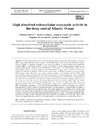Identificador persistente para citar o vincular este elemento:
https://accedacris.ulpgc.es/jspui/handle/10553/51639
| Campo DC | Valor | idioma |
|---|---|---|
| dc.contributor.author | Baltar, Federico | en_US |
| dc.contributor.author | Aristegui, Javier | en_US |
| dc.contributor.author | Gasol, Josep M. | en_US |
| dc.contributor.author | Sintes, Eva | en_US |
| dc.contributor.author | Van Aken, Hendrik M. | en_US |
| dc.contributor.author | Herndl, Gerhard J. | en_US |
| dc.contributor.other | Baltar, Federico | - |
| dc.contributor.other | Gasol, Josep M | - |
| dc.contributor.other | Aristegui, Javier | - |
| dc.contributor.other | Sintes, Eva | - |
| dc.contributor.other | Herndl, Gerhard | - |
| dc.date.accessioned | 2018-11-25T02:25:36Z | - |
| dc.date.available | 2018-11-25T02:25:36Z | - |
| dc.date.issued | 2010 | en_US |
| dc.identifier.issn | 0948-3055 | en_US |
| dc.identifier.uri | https://accedacris.ulpgc.es/handle/10553/51639 | - |
| dc.description.abstract | The distribution of prokaryotic abundance (PA), prokaryotic heterotrophic production (PHP), and suspended particulate organic material (POM), as well as total and dissolved (operationally defined as passing through 0.2 µm pore size filters) potential extracellular enzymatic activities (EEA; α- and β-glucosidase [AGase and BGase], leucine aminopeptidase [LAPase], and alkaline phosphatase [APase]) were determined in the meso- and bathypelagic waters of the (sub)tropical Atlantic along an eastern zonal transatlantic transect and a western N-S transect. Significant differences between both transects were found for POM concentration but not for PA, PHP (except in the subsurface and oxygen minimum layer), and dissolved and total EEA. PHP decreased by 3 orders of magnitude from the lower euphotic zone to bathypelagic waters, while PA and cell-specific PHP decreased only by 1 and 2 orders of magnitude, respectively. The proportion of the dissolved to the total EEA was high in the dark ocean for all the enzymes, ranging from 54 to 100, 56 to 100, 65 to 100 and 57 to 97% for AGase, BGase, LAPase and APase, respectively. The kinetic parameters (Vmax and Km) of both the dissolved and total fractions of LAPase and APase were very similar throughout the water column, suggesting a similar origin for both dissolved and particulate EEA. Significant correlations of both dissolved and total EEA were found with prokaryotic metabolism and the POM pool. Based on the previous notion that the fraction of dissolved EEA is higher in particle-attached than in free-living microbes, our results suggest that microbial activity in the dark ocean occurs mainly on colloidal and particulate material. This is in agreement with recent genomic evidence. However, these colloidal and particulate materials are prone to disruption during the sampling process. Hence, more selective sampling techniques are needed to specifically collect these deep-water aggregates that probably represent hotspots of microbial activity in the deep ocean. | en_US |
| dc.language | eng | en_US |
| dc.publisher | 0948-3055 | |
| dc.relation.ispartof | Aquatic Microbial Ecology | en_US |
| dc.source | Aquatic Microbial Ecology [ISSN 0948-3055], v. 58 (3), p. 287-302 | en_US |
| dc.subject | 251001 Oceanografía biológica | en_US |
| dc.subject.other | Dissolved extracellular enzymatic activity | en_US |
| dc.subject.other | Prokaryotic heterotrophic production | en_US |
| dc.subject.other | Particulate organic matter | en_US |
| dc.subject.other | Deep ocean | en_US |
| dc.title | High dissolved extracellular enzymatic activity in the deep central Atlantic ocean | en_US |
| dc.type | info:eu-repo/semantics/Article | en_US |
| dc.type | Article | en_US |
| dc.identifier.doi | 10.3354/ame01377 | |
| dc.identifier.scopus | 77952395895 | - |
| dc.identifier.isi | 000275496100007 | - |
| dcterms.isPartOf | Aquatic Microbial Ecology | |
| dcterms.source | Aquatic Microbial Ecology[ISSN 0948-3055],v. 58 (3), p. 287-302 | |
| dc.contributor.authorscopusid | 23476314200 | - |
| dc.contributor.authorscopusid | 7006816204 | - |
| dc.contributor.authorscopusid | 7003299234 | - |
| dc.contributor.authorscopusid | 15833225000 | - |
| dc.contributor.authorscopusid | 7202279291 | - |
| dc.contributor.authorscopusid | 7005513845 | - |
| dc.description.lastpage | 302 | - |
| dc.description.firstpage | 287 | - |
| dc.relation.volume | 58 | - |
| dc.investigacion | Ciencias | en_US |
| dc.type2 | Artículo | en_US |
| dc.contributor.daisngid | 1232580 | - |
| dc.contributor.daisngid | 227201 | - |
| dc.contributor.daisngid | 97985 | - |
| dc.contributor.daisngid | 935469 | - |
| dc.contributor.daisngid | 618266 | - |
| dc.contributor.daisngid | 99734 | - |
| dc.identifier.investigatorRID | C-3260-2012 | - |
| dc.identifier.investigatorRID | B-1709-2008 | - |
| dc.identifier.investigatorRID | D-5833-2013 | - |
| dc.identifier.investigatorRID | H-8494-2015 | - |
| dc.identifier.investigatorRID | B-1513-2013 | - |
| dc.utils.revision | Sí | en_US |
| dc.contributor.wosstandard | WOS:Baltar, F | |
| dc.contributor.wosstandard | WOS:Aristegui, J | |
| dc.contributor.wosstandard | WOS:Gasol, JM | |
| dc.contributor.wosstandard | WOS:Sintes, E | |
| dc.contributor.wosstandard | WOS:van Aken, HM | |
| dc.contributor.wosstandard | WOS:Herndl, GJ | |
| dc.date.coverdate | Julio 2010 | |
| dc.identifier.ulpgc | Sí | es |
| dc.description.jcr | 2,089 | |
| dc.description.jcrq | Q1 | |
| dc.description.scie | SCIE | |
| item.fulltext | Con texto completo | - |
| item.grantfulltext | open | - |
| crisitem.author.dept | GIR IOCAG: Oceanografía Biológica y Algología Aplicada | - |
| crisitem.author.dept | IU de Oceanografía y Cambio Global | - |
| crisitem.author.dept | Departamento de Biología | - |
| crisitem.author.orcid | 0000-0002-7526-7741 | - |
| crisitem.author.parentorg | IU de Oceanografía y Cambio Global | - |
| crisitem.author.fullName | Arístegui Ruiz, Javier | - |
| Colección: | Artículos | |
Citas SCOPUSTM
94
actualizado el 08-jun-2025
Citas de WEB OF SCIENCETM
Citations
90
actualizado el 08-jun-2025
Visitas
127
actualizado el 14-dic-2024
Descargas
133
actualizado el 14-dic-2024
Google ScholarTM
Verifica
Altmetric
Comparte
Exporta metadatos
Los elementos en ULPGC accedaCRIS están protegidos por derechos de autor con todos los derechos reservados, a menos que se indique lo contrario.
